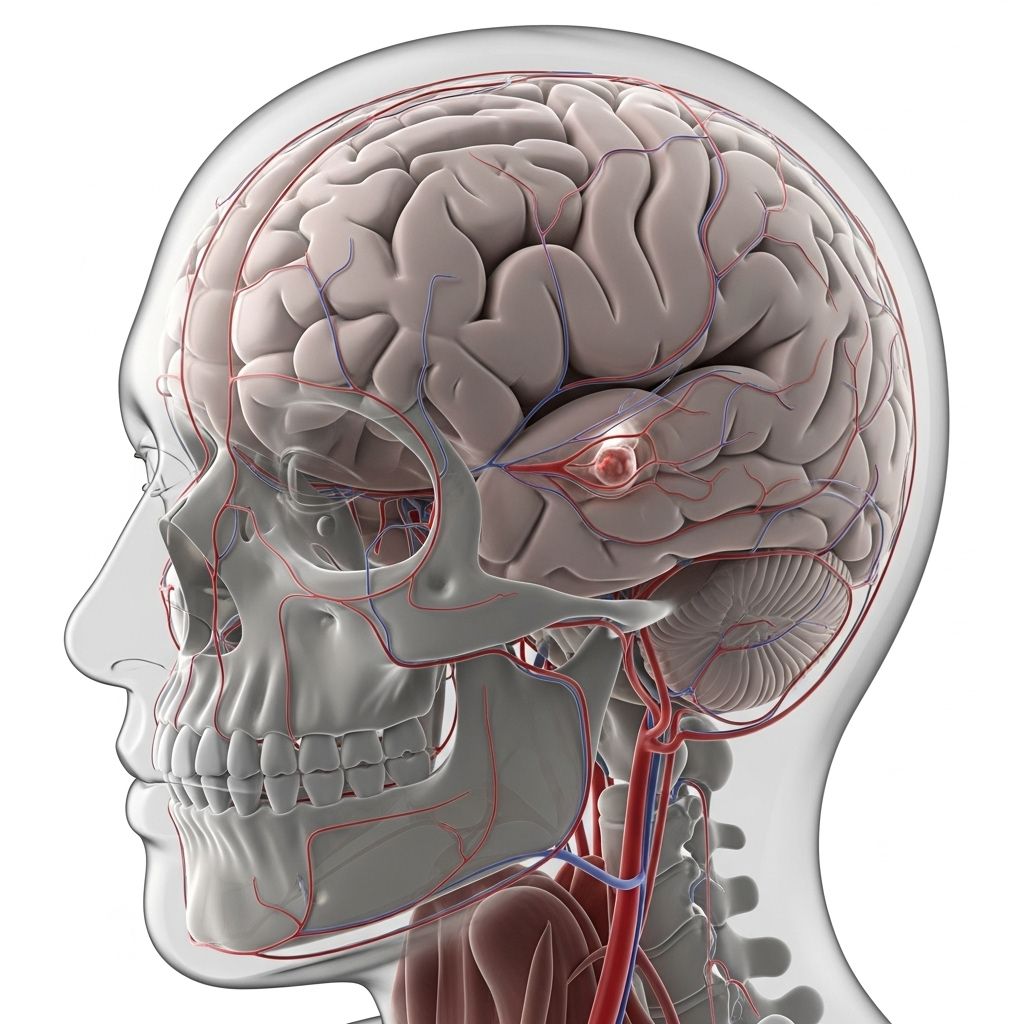Cerebral Venous Sinus Thrombosis: Causes, Symptoms, Diagnosis, and Treatment
A comprehensive guide to understanding cerebral venous sinus thrombosis, including its symptoms, causes, diagnosis, treatment options, and prevention.

Cerebral Venous Sinus Thrombosis (CVST): An Overview
Cerebral venous sinus thrombosis (CVST) is a rare but serious type of stroke caused by a blood clot in the brain’s venous sinuses. These clots prevent the normal drainage of blood from the brain, leading to increased intracranial pressure, swelling, and potentially bleeding within the brain.
CVST can affect adults and children. While it may sometimes resolve with timely treatment, it can also cause severe neurological damage or prove fatal if left untreated.
This article explores the causes, symptoms, risk factors, diagnostic approaches, treatments, and prevention strategies for CVST.
What is a Cerebral Venous Sinus?
The cerebral venous sinuses are large channels collecting blood from the brain and directing it back to the heart. The venous sinuses differ from regular blood vessels as they are located in spaces between layers of the brain’s covering (the dura mater). When a blood clot blocks one of these sinuses, the result is “cerebral venous sinus thrombosis.”
What is Cerebral Venous Sinus Thrombosis (CVST)?
CVST occurs when a clot forms in the brain’s venous sinuses, impeding the outflow of blood and leading to increased pressure, which can cause swelling, damaged tissue, and brain bleeding.
It is considered a rare form of stroke, with estimates ranging from 2 to 15 cases per million people annually. Both adults and children can be affected, although children (especially infants and babies) experience it at a slightly lower frequency than adults.
Prompt recognition and treatment of CVST can dramatically improve outcomes and reduce the risk of serious complications.
Causes and Risk Factors for CVST
While the exact cause sometimes remains unknown, several factors increase the risk of developing cerebral venous sinus thrombosis:
- Use of estrogen-containing medications (such as oral contraceptives or hormone therapy)
- Pregnancy and the postpartum period (especially first six weeks after childbirth)
- Inherited clotting disorders (e.g., Factor V Leiden, protein C/S deficiency, antithrombin deficiency, prothrombin gene mutation, hyperhomocysteinemia)
- Inflammatory diseases (lupus, sarcoidosis, Behçet disease, granulomatosis with polyangiitis, inflammatory bowel disease)
- Nephrotic syndrome (kidney disorder that leads to clotting tendency)
- Antiphospholipid syndrome (a condition that increases blood clot risk)
- Cancer (certain types can make blood more likely to clot)
- Head injury, trauma, or recent neurosurgery
- Infections of the head/neck (meningitis, sinusitis, otitis, mastoiditis)
- Certain medications (tamoxifen, chemotherapy drugs)
- COVID-19 infection and, rarely, after some COVID-19 vaccines
It’s important to note that in some cases, no clear risk factors are identified, making diagnosis challenging. Patients can also have more than one risk factor simultaneously.
CVST affects people of all ages and backgrounds—though women, especially those who are pregnant or using hormonal therapy, are at increased risk.
Symptoms of Cerebral Venous Sinus Thrombosis
Symptoms of CVST can vary depending on the location and size of the blood clot. They may appear suddenly or develop gradually, often worsening over the course of days or weeks.
- Headache (occurs in up to 90% of cases; may be severe, persistent, and worsen when lying down)
- Seizures
- Nausea and vomiting
- Weakness or numbness in the face, arm, or leg—usually on one side (called focal neurological deficit)
- Difficulty speaking or understanding speech
- Vision problems (blurred, double vision, brief episodes of gray or black vision)
- Dizziness, loss of balance or coordination
- Loss of consciousness, altered mental status, or even coma (in severe cases)
In approximately one-third of cases, headache is the only symptom. More severe symptoms (such as coma or seizures) are less common but can develop if the disease progresses untreated.
| Symptom | Frequency/Notes |
|---|---|
| Headache | ~90% of cases; often severe |
| Seizure | Up to 40% of cases |
| Nausea/Vomiting | Common; may accompany headache |
| Weakness/Numbness | May affect face, arm, leg (usually one side) |
| Vision Changes | Blurring, double vision, transient black/gray vision |
| Loss of Consciousness/Coma | Rare; severe cases |
When to Seek Medical Attention
Immediate medical attention is essential if you experience:
- Severe or worsening headache, especially if unrelieved by painkillers or worsens when lying down/bending over
- Headache accompanied by blurred vision, confusion, nausea, vomiting, weakness, drowsiness, or seizures
- Eye pain or swelling of one or both eyes
- Unexplained rash resembling bruises or bleeding under the skin
- Shortness of breath, chest pain, leg swelling, persistent abdominal pain
These symptoms may indicate CVST or other life-threatening conditions and should be evaluated promptly.
How is CVST Diagnosed?
Diagnosing CVST requires a combination of medical history, physical examination, and diagnostic tests. Because symptoms can mimic other neurological conditions (including conventional stroke), a prompt and thorough evaluation is crucial.
- Imaging studies (most important for diagnosis):
- CT scan (computerized tomography): May identify bleeding or swelling; specialized “CT venogram” can reveal clots
- MRI (magnetic resonance imaging): Shows detailed brain structures; “MR venogram” highlights venous sinuses and clots
- Blood tests: Assess clotting function, investigate inherited or acquired clotting disorders, infection, or inflammation
Prompt diagnosis is key to preventing brain damage or other complications. In emergency situations, treatment may be initiated based on clinical suspicion even before imaging is complete.
Treatment Options for Cerebral Venous Sinus Thrombosis
The mainstay of CVST treatment is anticoagulation (blood-thinning) therapy to prevent new clots and stop existing ones from enlarging. Treatment options are tailored to symptom severity, presence of complications, underlying cause, and patient factors (such as pregnancy).
Initial Therapy
- Heparin: Administered intravenously or by injection; rapidly prevents further clotting
- Other Anticoagulants: May be used in certain cases, such as direct oral anticoagulants (DOACs) including rivaroxaban, apixaban, dabigatran
- Anti-epileptic drugs: To prevent or treat seizures if present
- Measures to reduce intracranial pressure: Especially if there is swelling or threat of brain damage
Advanced or Rescue Therapies
- Thrombolytic (clot-dissolving) drugs: Delivered in severe cases (risk of bleeding high, used judiciously)
- Thrombectomy: Surgical or catheter-based clot removal when medication does not suffice
- Treatment of underlying infection (if CVST was caused by infection, especially in cavernous sinus thrombosis)
Long-term Management
- Transition to oral anticoagulants (e.g., warfarin): Maintains blood-thinning effect after initial stabilization
- Duration of therapy: Typically 3–12 months, but may be longer for people with persistent risk (e.g., inherited clotting disorder)
- Special populations: Pregnant women should avoid warfarin, as it is associated with birth defects; alternative anticoagulants are considered
- Monitoring for recurrence: Regular follow-up, blood tests, and imaging may be needed
Prompt, targeted therapy maximizes the chance of recovery and minimizes complications.
Complications of Cerebral Venous Sinus Thrombosis
- Stroke (due to brain tissue damage from bleeding or lack of drainage)
- Persistent neurological deficits (weakness, speech problems, vision loss)
- Seizure disorders (may persist even after acute phase)
- Coma or death (in severe or untreated cases)
- Recurrence of clots (especially in those with ongoing risk factors)
With timely diagnosis and treatment, many patients recover completely or with minimal long-term effects.
Special Considerations: Cavernous Sinus Thrombosis
Cavernous sinus thrombosis is a related but distinct form of venous sinus thrombosis. It involves the hollow spaces behind the eyes and can be life-threatening, typically caused by infection spreading from the face or skull.
Symptoms often include:
- Sharp, severe headache (often around the eye)
- Eye pain and swelling, bulging of the eye(s)
- Double vision
- High fever
Treatment requires management of the underlying infection, possible surgical drainage, and anticoagulants. Rapid recognition and intervention are crucial due to the risk of blindness or death.
Prevention and Risk Reduction
While not all cases of CVST can be prevented, strategies to reduce risk focus on managing underlying conditions and risk factors:
- Avoiding unnecessary use of estrogen-containing drugs
- Careful monitoring during pregnancy and postpartum
- Treating infections promptly
- Managing chronic inflammatory or clotting disorders with specialist guidance
- Regular follow-up for those with a history of thrombosis or inherited clotting tendency
Patient education about medication risks, symptom recognition, and the importance of urgent medical care is essential.
Outlook and Prognosis
With modern diagnostic and therapeutic approaches, most people with CVST survive and recover fully, especially when treatment is initiated early.
Recovery time may vary depending on the severity of symptoms and presence of complications.Regular neurological follow-up is often recommended to detect and manage lingering deficits or recurrent thromboses.
Frequently Asked Questions (FAQs)
Q: Who is most vulnerable to CVST?
A: Women (especially those who are pregnant or using oral contraceptives), patients with clotting disorders, people with recent head injuries or infections, and those undergoing hormone therapy have higher risk.
Q: What should I do if I suspect CVST?
A: Seek emergency medical attention immediately. Prompt diagnosis and treatment are essential for the best outcomes.
Q: Can children get CVST?
A: Yes, CVST can affect children and infants, though it is rare. The presentation may differ slightly, but prompt recognition and treatment are equally critical.
Q: How long will I need blood-thinning treatment?
A: Most people require blood thinners for 3 to 12 months, depending on the underlying cause and risk factors. Some with inherited clotting disorders may need lifelong therapy.
Q: Is recurrence possible?
A: Yes, especially for those who have ongoing risk factors. Regular follow-up and adherence to treatment protocols are essential to minimize risk.
Q: Can CVST follow vaccination?
A: In extremely rare cases, CVST has occurred after certain COVID-19 vaccinations. If you experience headache, stomach pain, leg pain, or shortness of breath within three weeks of vaccination, contact your healthcare provider promptly.
Summary Table: CVST At-A-Glance
| Aspect | Details |
|---|---|
| Common Symptoms | Headache, weakness, seizures, vision changes, nausea |
| Key Risk Factors | Oral contraceptives, pregnancy, clotting disorders, infections, trauma |
| Diagnosis | CT/MRI venogram, blood tests |
| Main Treatment | Heparin, other anticoagulants, possible surgery |
| Complications | Stroke, neurological deficits, coma, death |
| Prognosis | Favorable with early treatment; ongoing risk for recurrence |
Conclusion
Cerebral venous sinus thrombosis, though rare, is a potentially life-threatening condition requiring urgent medical attention. Awareness of its risk factors, symptom recognition, and robust treatment protocols can ensure optimal recovery for most patients. Ongoing research continues to improve diagnostic accuracy and therapeutic outcomes.
References
- https://www.yalemedicine.org/conditions/cerebra-venous-sinus-thrombosis-cvst
- https://www.urmc.rochester.edu/conditions-and-treatments/cerebral-venous-sinus-thrombosis
- https://www.nhs.uk/conditions/cavernous-sinus-thrombosis/
- https://my.clevelandclinic.org/health/diseases/22560-cerebral-venous-sinus-thrombosis
- https://www.ahajournals.org/doi/10.1161/STR.0000000000000456
- https://www.ncbi.nlm.nih.gov/books/NBK560598/
- https://www.childrenshospital.org/conditions/cerebral-venous-thrombosis
Read full bio of medha deb












